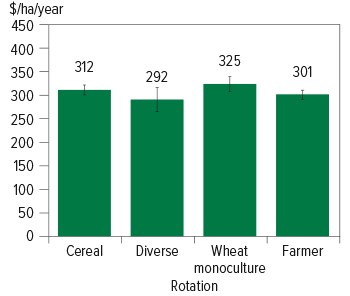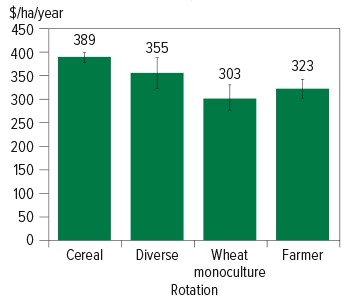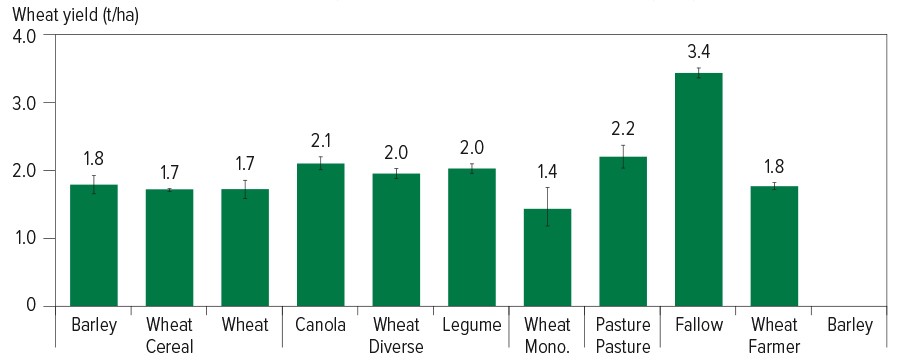Key points
- The profitability of crop sequences in long-term trials is the performance indicator of most interest to growers
- Consistent income from wheat and barley made continuous cereals the most profitable rotation
- The key to maintaining soil organic carbon was to minimise use of fallow and ensure uniform residue spread
- Windrow burning can assist weed and residue management
- Long-term trials provide the opportunity to assess systems effects of treatments and add to the scientific knowledge base and the training of future system scientists
The Western Australian No-Tillage Farmers Association (WANTFA) long-term field trial, which ran from 2006 to 2019, was designed to test and further develop high-quality no-till systems based on the conservation agricultural principles of permanent soil cover, minimal soil disturbance and diverse crop rotations.
In partnership with WANTFA, the University of Western Australia (UWA) and CSIRO, and with investment from GRDC, the trial has not only yielded a wealth of scientific understanding of crop performance, residue impacts, soil health, water use and weeds and diseases, but also leaves a legacy of contributions to scientific literature, a reference dataset and expertise for agriculture.
Associate Professor Ken Flower from UWA has been involved since the start of the long-term trial. “For over a decade, the trial has not only generated a wealth of information but also provided a focus for local, interstate and international visitors to discuss and share ideas at annual field days and crop walks,” Dr Flower says.
Background
Although no-till crop production systems have shown benefits for growers in Australia, such as timeliness of operations, moisture harvesting, erosion control and higher yields, production in no-till systems had reached a plateau by the mid-2000s.
“There were also further questions about how much organic carbon could be stored in the soil and the optimum amount of retained residue,” Dr Flower says.
In addition, the sustainability of no-till in WA was being questioned because herbicide resistance was on the increase. This led WANTFA to commission Dr Rolf Derpsch, an international no-till consultant from Paraguay, to carry out a situation analysis of no-till in WA in 2005.
Lack of soil cover, inadequate diversity in rotations, herbicide resistance and weed control were identified by Dr Derpsh as the major challenges for the Australian system.
“Practices such as overgrazing, burning, tillage and poor crop rotation were thought to be contributing to the problems,” Dr Flower says.
WA’s grain enterprises have been dominated by cereals, particularly wheat, largely due to poor economic returns from other crops when grown under dry conditions. As a consequence, the area sown to alternative crops such as lupins and other grain legumes has declined.
Dr Derpsch recommended that no-till systems in WA should be based on full stubble retention, diverse rotations with cover crops and a more holistic approach to weed management.
This long-term project, which was designed to test and further develop these recommendations, particularly the types of rotations in light of grower experience, commenced in 2006 at the Western Australian College of Agriculture, Cunderdin, 156 kilometres east of Perth.
The trial has occupied 10 hectares on a red alkaline sandy clay loam, which is relatively heavy for the region. The average annual rainfall at the site from 2007 to 2018 was 306 millimetres, with 216mm in the growing season. Eight of the 12 years had below-average rainfall, with 2010 being a severe drought.
The treatments were based on different cropping philosophies with specific aims as described in Table 1. The treatments had three-year rotations with each phase grown every year, except for wheat monoculture and permanent pasture. The crops and cultivars were changed periodically, within the rotation, to ensure they remained relevant to growers.
Table 1: Rotations and associated aims
Rotation | Description/philosophy |
|---|---|
| Cereal rotation | Aim: ‘maximum carbon input’. Relatively low crop diversity with maximum residue retention. Three-year rotation with cereals only and every cereal type present every year. Crops seeded with a minimum disturbance disc opener. No whole-paddock burning or tillage. |
| Diverse rotation | Aim: ‘maximum diversity’. High crop diversity with maximum residue retention. Diverse three-year rotation (cereal/legume/brassica) with every phase presented every year. Crops seeded with a minimum disturbance disc opener. No whole-paddock burning or tillage. |
| Wheat monoculture | Aim: ‘no diversity’. No crop diversity with maximum residue retention under continuous wheat. Crops seeded with a minimum disturbance disc opener. No burning or tillage. |
| Pasture | Aim: ‘continuous pasture’. Mowing and weed wiping allowed. |
| Grower rotation | Aim: “maximum profit”. Similar to current grower practice with lower residue retention. Three-year rotation (cereal/cereal/legume or fallow) with every phase presented every year. Crops sown with a higher disturbance tine and knife-point no-till seeder. Burning and tillage allowed. |
Source: WANTFA
Understanding and optimising a farming system
“The biggest challenge of tracking a farming system over time is capturing the correct data, right from the beginning, to gauge effects of treatments as the trial evolves,” Dr Flower says.
The profitability of the various treatments was the performance indicator of most interest to growers from the long-term trial.
Wheat monoculture was the most profitable of the rotations over the 12 years (Figure 1). This was largely because of the relatively stable wheat income, even in dry years, and the negative impact of growing cover crops in the first three years of the trial in the cereal and diverse rotations. Cover crops in the rotation had no grain income and little positive effect on subsequent crop yield.
Figure 1: Rotation mean gross margins ($/ha/year) from 2007 to 2018. Error barrror (n=9, except for monoculture wheat n=3).s are ±Standard error

Source: WANTFA
“Cover crops should not be recommended under low-rainfall conditions in these Mediterranean-type environments, unless for grazing, and we have not seen the use of these crops in these regions to any extent,” Dr Flower says.
After 2009, when no cover crops were included, the most profitable rotation was the cereal rotation (Figure 2). Again, this reflected the consistent income from wheat and barley, compared to canola in the diverse rotation. The legumes (field peas, narrow-leaved and albus lupins) also had inconsistent income in this environment. The cereal rotation maintained higher yields than the wheat monoculture, but, compared to the more-diverse grower rotation, required higher nitrogen top-dressings and had higher disease levels and weed numbers, so careful management was required.
The decreased gross margin in wheat monoculture after 2009 (Figure 2) was due to declining yields in the latter years of the trial. This was due to greater build-up of weeds, disease and declining fertility and was clearly illustrated when wheat was grown over all plots in 2019, at the end of the trial (Figure 3).
Wheat in monoculture yielded 1.4 tonnes per hectare, compared to an ‘average’ wheat yield of 1.8 to 2t/ha following most of the other rotations.
Figure 2: Rotation mean gross margins ($/ha/year) from 2010 to 2018. Error bars are ±Standard error (n=9, except for monoculture wheat n=3).

Source: WANTFA
Wheat after long-term pasture yielded slightly higher (2.2t/ha), whereas wheat yield after fallow was even higher at 3.4t/ha, reflecting the value of ‘saved water’. Despite this, the gross margin in the grower rotation was still relatively low due to the impact of one year of fallow in three from 2013 onwards. Nonetheless, occasional fallow can be used to introduce more diversity in the rotation by providing some ‘drought proofing’.
Figure 3: Wheat yield in 2019, when wheat was grown across all plots at the end of the trial. X-axis shows last crop grown in the different rotations (no wheat crop was grown after barley in the grower rotation). Error bars are ±Standard error (n=3).

Source:WANTFA
“Indeed, growers are already using fallow as a means of improving the reliability of canola in the low-rainfall areas of Western Australia,” Dr Flower says.
Overall, results suggest a rotation based on cereals with some diversity, perhaps including occasional fallow in low-rainfall areas, may offer the highest potential profitability and be more sustainable in the long term.
Crop residue management
The residue effect on the crops was complex. High amounts of cereal residue at seeding (exceeding 3 to 4t/ha) reduced emergence and yield in wet or frost years but had the reverse effect – a benefit – in dry years. High residue amounts also had an effect on herbicide efficacy and research showed that some herbicides were more suited to these situations than others.
“The trial showed that growers can manipulate residue levels through their rotations – greater intensity of cereals increasing residue amounts and more-diverse rotations decreasing residue,” Dr Flower says.
On top of this, residue amounts increased following years of high rainfall and good crop growth and declined with lower rainfall.
Windrow burning before seeding also reduced residue by about 50 per cent compared to spreading the residue.
In some years, there was poor uniformity of stubble spread with greater residue accumulating directly behind the harvester – a discrepancy inherent in particular harvester makes. By the end of the trial, there were higher nutrients, soil organic carbon and total nitrogen where this residue had accumulated. The situation was exacerbated with windrow burning, where higher concentrations were found in the windrow position compared to positions off the windrow.
Dr Flower says research and engagement with machinery manufacturers to better understand and improve the uniformity of stubble spread behind harvesters is needed, especially in controlled-traffic systems and with the cutting width of harvesters increasing.
More research on the management of residue before seeding and its handling by seeders is also important.
Organic carbon accumulation
Dr Flower says soil organic carbon concentration is a useful indicator of the sustainability of a crop rotation.
Organic carbon concentration fluctuated over the 12 years of the experiment and concentrations appeared to be affected more by rainfall and growing conditions than crop rotation.
Concentrations declined following droughts and increased after good seasons with higher biomass/yield. Concentrations also appeared to be in decline in the grower rotation after the introduction of the fallow. Within the different rotations, soil organic carbon was affected by residue distribution, with higher concentrations correlating with areas of highest residue concentration.
“It was evident the key to maintaining soil organic carbon was to minimise use of fallow and ensure uniform spread of residue.”
Water use
Overall, there was a pattern for the legumes, except narrow-leaved lupins, to use the least soil water and for wheat following the fallow to use the most soil water. However, crops grown after fallow did not dry the soil profile to the same extent as when following a crop, even though there was deeper root activity.
“This suggests there is ‘unused’ water in rotations with fallow,” Dr Flower says.
Rooting depths varied from 110 to 160 centimetres, depending on the crop. Compared to wheat, canola appeared to dry the soil less in the mid-depths (40 to about 70 to 90cm) and slightly more at greater depths.
The legumes showed a similar pattern – drying out the mid-depths less than wheat, although for most legumes, except narrow-leaved lupins, the rooting depth was shallower than wheat.
Weed management
Dr Flower says one integrated weed management approach used in the trial was windrow burning.
Overall, the seedbank data confirmed the effectiveness of windrow burning to reduce weed numbers across all the rotations. Another trend was for higher ryegrass numbers in wheat monoculture and with shallow tillage.
Weed dry mass was always lower with windrow burning compared to retained residue, except with canola, which had low weed dry mass and few differences. Windrow burning appeared to be particularly effective in reducing weed growth in the legume phase of the rotation.
Industry legacy
Twelve years of research has produced a vast amount of data on soil, weeds, disease, plant counts, biomass, and yield/quality data together with the economic data – inputs and prices – used to produce the gross margins over the seasons.
The soil data has been supplied to the Soil CRC Visualising Australasia’s Soils project. This is an interactive community resource that brings together soil-related datasets and information created and managed by government agencies, organisations, community groups and individuals across Australia and New Zealand.
“The sheer amount of data makes it complex and time-consuming to digest and interpret,” Dr Flower says.
He says the number of publications so far from this long-term trial reflects the breadth of the scientific understanding of cropping systems gained from the work.
It spans nitrogen and weed management, soil water balance and cover crops, residue management and foliar/root disease management in long-term trials under no-tillage.
Improved understanding of microbial dynamics in no-till soils and effects of crop residue levels on herbicide efficacy, together with the economics of the crop sequences, have also been shared with the scientific community.
The long-term trial has also been a resource for training opportunities for not only agricultural high school students at the Western Australian College of Agriculture, but also for training postgraduate and undergraduate students at UWA who are contributing to both Australian and international cropping industries.
More information: Dr Ken Flower, 0417 952 081, ken.flower@uwa.edu.au

























































